This archived website ‘James Ensor. An online museum.’ is temporarily not being updated. Certain functionality (e.g. specific searches in the collection) may no longer be available. News updates about James Ensor will appear on vlaamsekunstcollectie.be. Questions about this website? Please contact us at info@vlaamsekunstcollectie.be.
James Ensor and Photography
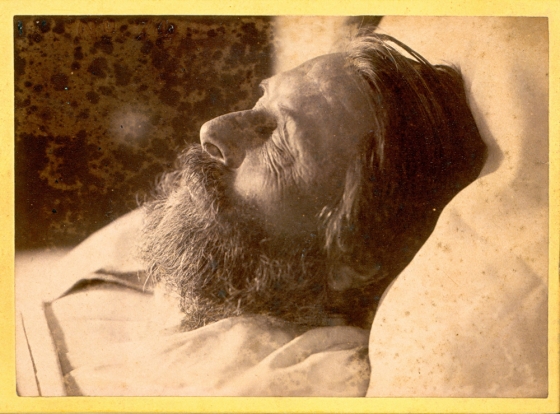
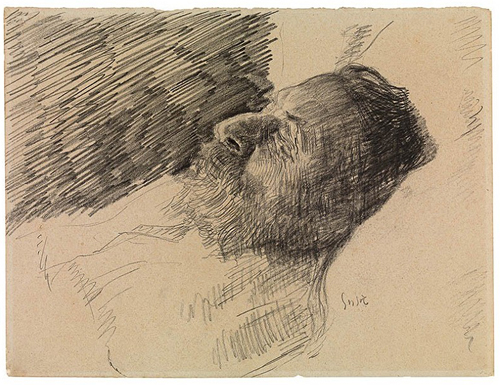
The oeuvre of James Ensor with relation to photography has as of yet hardly been examined. This is despite the fact that various works by Ensor are extant thanks to the use of photographs. Contrary to his contemporary Fernand Khnopff (1858-1921), Ensor himself never made photographs that could serve as work documents. The photos that Ensor used as a source of inspiration as work documentation were taken by a third party.
One of the first works that Ensor bases upon a photo is the drawing My Dead Father from 1887 (KMSKA, Antwerp). He completes a version in drypoint the year afterwards. The photograph is taken by the Ostend photographer Louis Ferdinand Le Bon (1856-1923). The French-native photographer establishes himself in Ostend in 1877. He settles first in an annex of the Hôtel de Flandre, and later on the corner of the Van Iseghemlaan and Louisastraat, where previously there was a studio (branch) from the famous lithographer Louis-Joseph Ghémar (1819-1873). Le Bon started a large souvenir business in 1899-1900 (until 1930) at Vlaanderenstraat 44 and in 1888 opened a branch in Zuidzandstraat 21 in Bruges. He also had a branch in Blankenberge. In 1896, his business was taken over by the photographer Ferdinand Buyle (1872-1950), who photographed Ensor in his studio in 1909.
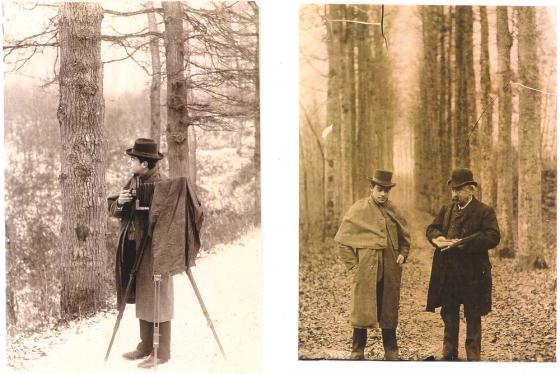
Some photographic portraits that Ensor later used are made by Ernest Rousseau junior. In 1889, James Ensor draws the portrait of Mariette Rousseau. It involves the drawing Mariette Rousseau at the Microscope (private collection), executed in charcoal and pencil on paper, affixed to panel. For this, Ensor bases it upon a photo by the young Rousseau. In an undated letter from March or April of 1889, Ensor writes to Mariette Rousseau:
'Don't forget to take the photograph and keep the profile prominent with the head bent and as if you are reading in a book that is placed quite low, with the chin touching the neck and a black garment with lace, I believe. The Giant [= Ernest Rousseau jr.] should make the photo well in good lighting and above all the head clear and grand, standing out in the light against a very dark background.' (Fonds Wodon, AHKB, KMSKB, Brussels, inv. 119.715)
Not happy with the pose that Mariette Rousseau assumes in the photo, he writes to her on 9 April 1889:
'The photograph is pretty, but shall not serve its purpose for me; you are not in a good pose. Ernest is not responsible, I am counting on him, or more so on you Madame or your exquisite pose, because I am going to complete the drawing and do it well.' (Fonds Rousseau, AHKB, KMSKB, Brussels, inv. 119.716)
Content with the (new) photo, he writes a few days later, on 13 April 1889, to the Rousseaus: The portrait photograph of Madame shall suffice. (Fonds Rousseau, AHKB, KMSKB, Brussels, inv. 119.718)
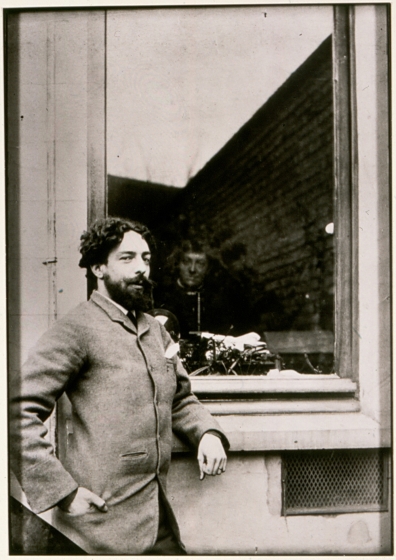
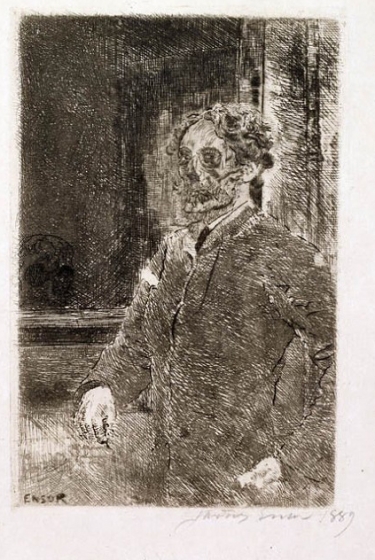
'I have received for the edition of La Plume the pleasant and serious lines of Lemonnier, Picard, Maeterlinck, Verhaeren, and Krains. Delattre is working on an important study on masks. Unfortunately, I do not have any good photography. You have promised me a proof of my portrait, which is the only decent photograph. I am counting on you. You do not have to photograph my painting L'intrigue nor Les choux. The latter is easily handled. The Colourist could also make a nice effect I believe. Also The Ray or Masks Mocking Death. (Fonds Rousseau, ACAB, RMFAB, Brussels, inv. no. 119.930)
The requested photograph is reproduced on page 1 of the special edition of La Plume, dedicated to James Ensor. (1) The letter also reveals that Ernest Rousseau junior makes photos of Ensor's paintings. On 24 July 1898, he repeats his request to Rousseau junior:
'I have also requested a photograph from you for La Plume. I don't have my portrait, and yours is quite nice. You have promised it to me. You can also photograph Le Chou, as it not too large, because that needs to fit in the edition. A painting easily handled, and I shall place in the edition of La Plume ‘belonging to Mr Ernest Rousseau'. As such, you will have an acquisition of a serious amateur in Paris. The edition shall be very good, and I have received a number of articles.' (Fonds Rousseau, AHKB, KMSKB, Brussels, inv. 119.931)
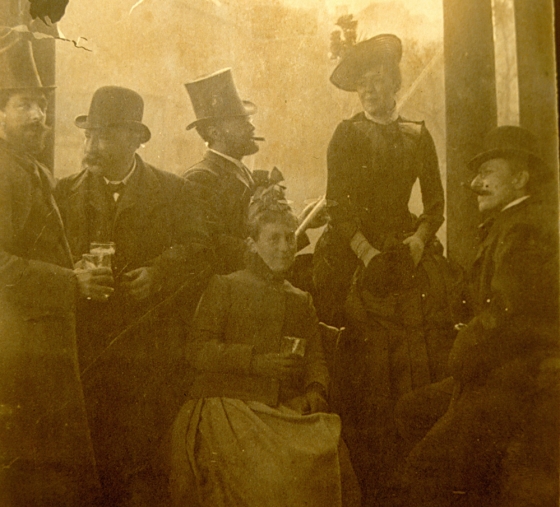
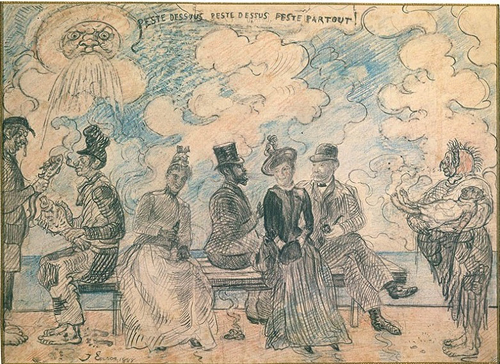
During a trip to Bruges on 22 April 1889, the young Ernest Rousseau takes a group photo in which James Ensor, Ernest and Mariette Rousseau, a person not yet identified and the Italian scientist and professor Antonio Roiti (1843-1921) are to be seen. This photograph shall serve as a source of inspiration for his drawing from 1888 (KMSK, Antwerp) and his etching from 1904, Plague here, Plague there, Plague everywhere [T. 27]
Both in the drawing and the etching the figures are rearranged, without Antonio Roïti, sitting next to each other on a bench.
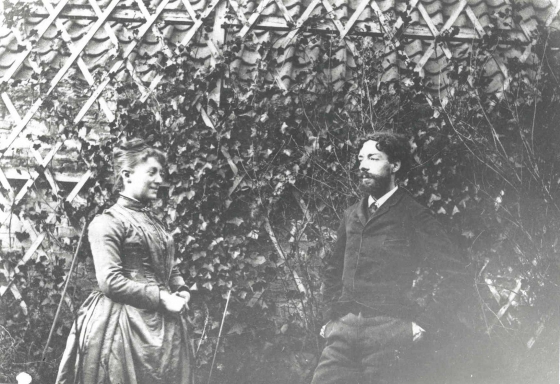
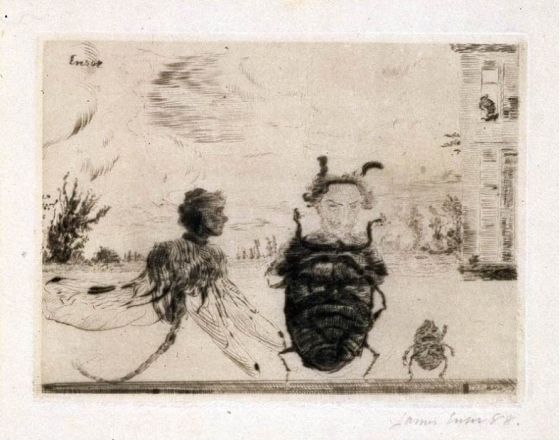
During one of the many visits by Ensor to the Rousseaus, Mariette Rousseau and the artist are photographed in the garden of the house at the Vautier Street. This image is probably also taken by Ernest Rousseau junior. The pose by Mariette Rousseau and Ensor inspired the artist for the drypoint Peculiar insects from 1888 [T. 46]. The subject refers to the poem by Heinrich Heine (1797-1856), Die Launen der Verliebten.
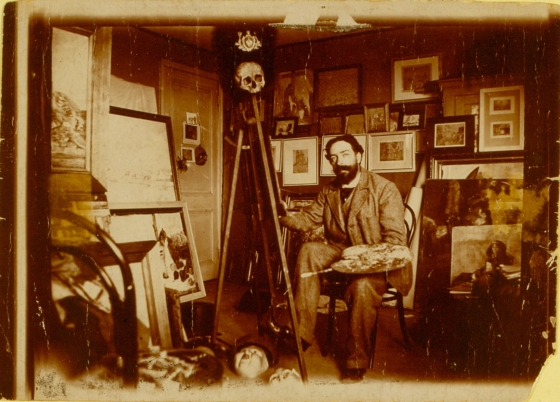
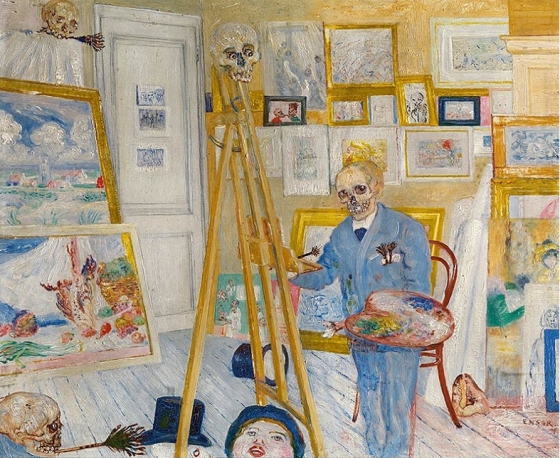
One of the young Ernest Rousseau's best friends was Eugène Labarre (also written La Barre), student at the Université Libre de Bruxelles, son of a supplier in photographic material, and later physician. In a letter, dated May 1892, to Ernest Rousseau Jr., Ensor writes:
I received the amusing photographs by Labarre. (Fonds Rousseau, ACAB, RMFAB, Brussels, inv. no. 119.766)
These photographs, taken on 15 April 1892, represent James Ensor and Ernest Rousseau Jr. fighting, bones in hand, in the dunes. One of the pictures served to paint a detail of Pierrot's Despair [Tr. 357], painted by Ensor in 1892.
In 1896 or 1897, James Ensor paints Skeleton Painting in his Studio (KMSKA, Antwerp) [Tr. 385]. The work presents Ensor as a skeleton in his studio, set up in a mansard room of the familial home on the corner of the Vlaanderenstraat and the Van Iseghemlaan in Ostend. The work is based upon a photo that appears for the first time on page 38 of La Plume. The painting is a quasi-exact copy of the photograph, but he depicts himself not as sitting before the easel, but standing up and with shortened legs, by which the artist looks somewhat dwarfish. He looks very self-confidently with a penetrating gaze right into the lens and presents himself according to the classical pattern of the painter in his natural environment. Just as with his mother's and grandmother's small shop, his studio is full of masks, skulls and unusual objects. Above the easel, we notice a skull with a sjako cap, which casts a perplexed look on the painter. All of the works that are present in the photograph are depicted one by one on the canvas. We recognise from left to right: Large View of Mariakerke from 1896 [Tr. 379]; The Dead Rooster from 1894 [Tr. 367]; The Dangerous Cooks from 1896 [Tr. 381]; The Descent from the Cross from 1886 [Tr. 281]; Skeletons Fighting over a Pickled Herring from 1891 [Tr. 335]; the etching The Cathedral from 1886 or the one from 1895 [T.7 or T.105]; the highlighted drawing The Battle of the Golden Spurs from 1891; the highlighted drawing The Calvary from 1886; the highlighted drawing Carnival in Brussels from 1888; the drawing Skeleton Musicians from 1888; the small oil painting Egg, Crabs and Shrimps from 1891 [Tr. 343]; the etching The Murder, 1888 [T. 38]; the uppermost portion of The Astonishment of the Mask Wouse, 1889 [Tr. 302]; the left portion of Afternoon in Ostend from 1881 [Tr. 218] and, finally the charcoal drawing of The Witch from 1883 (2) In his canvas Ensor added his oil painting The Dangerous Cooks which is absent on the photograph. Who took the photograph is not known, but given the quality of the photograph, it is quite possible that Ernest Rousseau junior is also the person who took it.
On 14 April 1893, Ensor writes to the Rousseau family:
'I am making a view of the street taken from the studio, which is going well before I shall make the hostile musicians. I have found an amusing subject and the portrait of Gevaert by Mr Ernest shall work very well for me. After I make the dangerous cooks, after a grand grisaille: an interior of a church but I must find the subject.' (Fonds Rousseau, AHKB, KMSKB, Brussels, inv. 119.803)
In his letter, Ensor mentions that he is working on 'a view of the street taken from the studio'. This deals with Van Iseghemlaan (Museum Van Buuren, Ukkel) [Tricot 362]. He likewise mentions that he shall paint a new work, based upon a portrait of Gevaert, taken by Ernest Rousseau junior. It involves the portrait of the Belgian composer and music teacher François-Auguste Gevaert (1828-1908), who is depicted in the work Au Conservatoire (Musée d'Orsay, Paris) [Tricot 404]. The work was catalogued by Verhaeren and Le Roy for the year 1903. (3) Thanks to this letter, we currently know that it was actually painted in 1893. Another letter, (18 July 1893) to Rousseau junior, confirms that it indeed deals with Au Conservatoire:
'I have represented Gevaert, Ysaye and the entire horrible clique of the conservatory under a shower of a bouquet of legumes, ducks, carrots, dogs and cats hurled at full force by an exasperated audience, in the background, an indignant Wagner covers his ears and the ladies of the conservatory intoning a desperate attempt to drown out the commotion.' (Fonds Rousseau, AHKB, KMSKB, Brussels, inv. 119.808/1)
In the work, François-Auguste Gevaert is depicted as director, Eugène Ysaÿe (1858-1931) as violinist and Richard Wagner in a caricature manner. Ensor also alludes to the opera Die Walküre from 1870. The preparatory drawing with the title Bourgeois indignés sifflant Wagner en 1880 � Bruxelles (private collection) was catalogued by Verhaeren and Le Roy for the year 1890. (4)
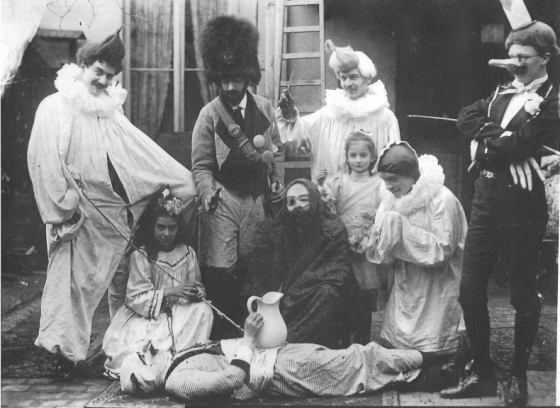
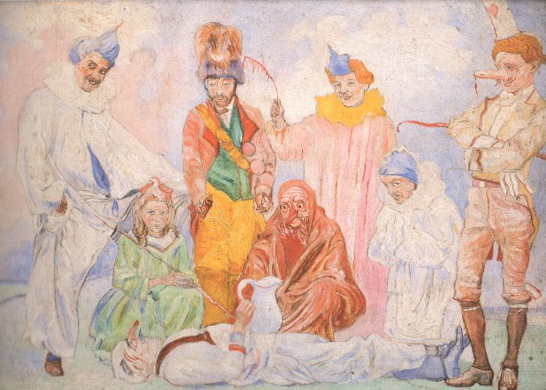
Other paintings, drawings and gravures are completed by Ensor on the basis of photographs by third parties. Some were reproduced in newspapers and periodicals. An explicit example is the etching Portrait of Elias Magnus Fries [T. 3] from 1886. The portrait of the Swedish botanist, professor and Dean of the University of Uppsala is a copy from a lithograph that is based upon the portrait made during the 1870's. The lithograph was made by the Central Tryckeriet (Central Printers) of Stockholm. Possibly, Ensor discovered the portrait of Fries in one of the many scientific books in the library of the Rousseau family. Mariette Rousseau and Élise Destrée (1832-1910), wife of Jean-Édouard Bommer (1829-1895), professor at the Brussels university, were both renowned experts in the study of mushrooms and fungi and regularly published their results in various scientific journals, amongst which was the Bulletin de la Société royale de Botanique de Belgique. In his letter from 3 December 1886 to Mariette Rousseau, Ensor writes:
'I am working a great deal. I have touched up the portrait of Frise [sic], I don't know if I am happy with it. It is more difficult than it seems. It is due to the shadow on the plate, the hatches are exposing the metal, which I dislike very much. [...] It is difficult to make the etching from a feeble lithograph and without character where the accents are blurred. The portrait as etching is not able to express this because of certain essential traits that are very sober. One could perfectly capture the essential lines when one is working from a living model or from another etching, but that becomes nearly impossible from a dull lithograph, in as much as the procedure is different. At any rate, we will make the print of it and I shall begin again if it is not good, but on copper. I do not wish to work any more on zinc that is too quickly corroded by the acid; one is not able to obtain any finessed grey or semi-tint as fine as those of Rembrandt. I have made a drawing on panel after the portrait of Mr Rembrandt. I am still waiting for that of Mr Ernest.' (Fonds Rousseau, AHKB, KMSKB, Brussels, inv. 119.688/1)
Ensor's letter provided a good insight into his vision of etching technique. In his letter he also writes that he is expecting the portrait of Ernest Rousseau. Perhaps this has to do with a photographic portrait of Rousseau senior made by Rousseau junior. (7) From here, we can deduce that his etching Portrait of Ernest Rousseau [T. 11] of 1887 is also engraved after a photo. (8)
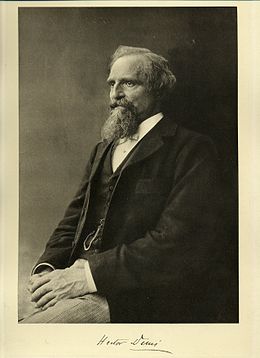
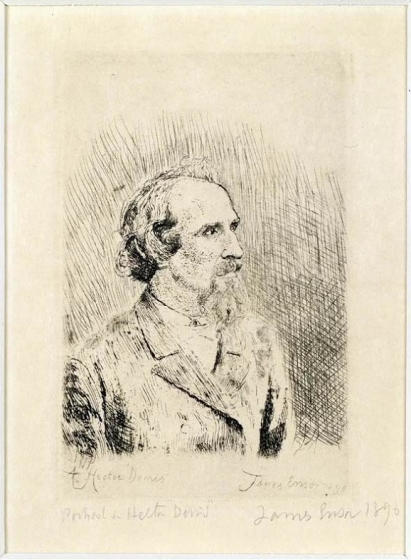
'You suggested resending the plates to me. I thank you. You can send me l'alimentation [= Doctrinal Nourishment], M. Denis [= Hector Denis] and the view of the city-I don't know if I shall dare to retouch the portrait. The lines and traits of an etching are always inevitably sharp and to make that from a vague photograph where the principle lines are not demarcating and from a general softness shall be toilsome work. It is also uncertain and risky to damage everything. I find the portrait sufficiently resembling, the construction amusing and the lines fine and elegant, a resemblance very exact not adding anything grand and that could be done by Tichon. Send it then and I shall look at it.' (Fonds Rousseau, AHKB, KMSKB, Brussels, inv. 119.743)
Hector Denis (1842-1913) graduated at the Université Libre de Bruxelles with a doctorate in Law (1865) and as a doctor in Natural Sciences (1868). He remains affiliated with the university; in 1879 became conditional professor and in 1886, full professor. During the years 1892-1894, he was elected as Rector. He primarily taught geography and national economy. Denis was a colleague and friend of Ernest Rousseau, who was likewise Rector of ULB for a few years.
Another prominent example is the portrait of the French philosopher and lexicographer Émile Littré (1801-1881), whom we find again posted lower right in Ensor's magisterial drawing The Entrance of Christ into Jerusalem (1885-1886, MSK, Ghent). The portrait is based upon a photographic portrait of the famous French photographer Nadar (pseudonym of Gaspard-Félix Tournachon, 1872-1920). The cover of the French periodical L'Illustration (Journal universel) of 11 June 1881 reproduces the portrait by Nadar. (9) Most likely Ensor based his drawing upon the reproduction of this photo.
Much later Ensor shall yet still paint a series of portraits, whether or not carried out by commission. In 1927, Ensor paints the portrait of his niece Alexandra Daveluy (1893-1966) [Tricot 581], daughter of his sister, and the portrait of Madame Albert Croquez [Tricot 582]. The following year he paints the portrait of his Parisian friend and lawyer Albert Croquez (1886-1949) [Tricot 583] and of the Ostend amateur painter Carol Deutsch (1894-1944) [Tricot 584].
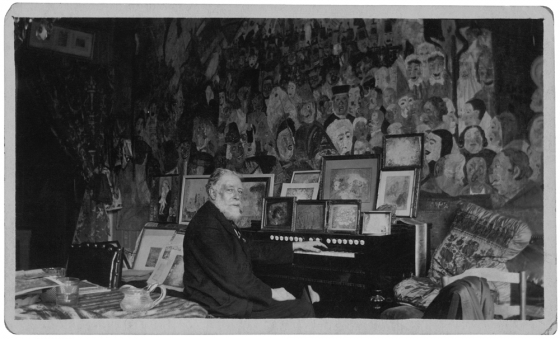
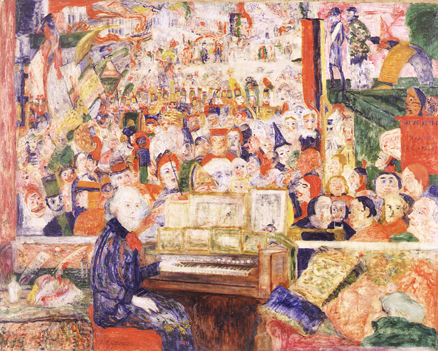
His painted portrait from April 1932, titled Ensor in his Studio or Ensor at the Harmonium (Menard Art Museum, Komaki) [Tricot 620] is based on a photograph, probably taken by one of his good friends, the French advocate and art collector Albert Croquez (1886-1949) or the Belgian painter Georges Creten (1887-1966).
Footnotes
(1) James Ensor. Peintre & Graveur, avec 111 illustrations de James Ensor, Paris, Librairie de la Société Anonyme ‘La Plume', 1899.
(2) See my essay "James Ensor in zijn atelier", exh. cat. Bij Ensor op bezoek, Ostend, Mu.ZEE, 2010.
(3) Émile Verhaeren, James Ensor, Brussels, 1908, p. 122; Grégoire Le Roy, James Ensor, Brussels/Paris, 1922, p. 188.
(4) Émile Verhaeren, James Ensor, Brussels, 1908, p. 116; Grégoire Le Roy, James Ensor, Brussels/Paris, 1922, p. 183.
(5) In 1896, Ensor completes his etching Menu for Ernest Rousseau, 1896 [T. 109] on the occasion of the marriage of Ernest Rousseau junior to Milly Nahrath.
(6) Symbol of Freedom from the revolutionary French Republicans.
(7) A photographic portrait, possibly taken by Ernest Rousseau junior, was depicted in the book James Ensor. Tekeningen en prenten (Drawings and prints) by Robert Hoozee, Sabine Bown-Taevernier, J.F. Heijbroek, Antwerp, 1987, p. 207.
(8) Up until the present day, it was accepted that the etching by Ensor is made after the bust of Ernest Rousseau by the Flemish sculptor Jef Lambeaux.
(9) L'Illustration. Journal universel, 39th year, vol. LXXVII, no. 1998, 11 June 1881.







